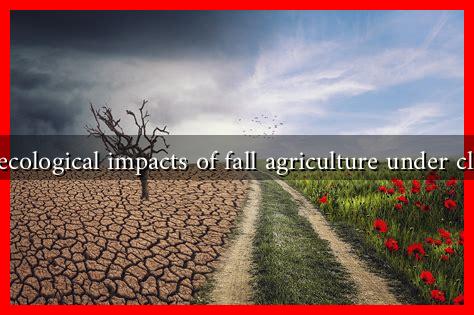-
Table of Contents
- What are the Ecological Impacts of Fall Agriculture Under Climate Change?
- The Changing Climate: An Overview
- Ecological Impacts of Fall Agriculture
- 1. Soil Health and Erosion
- 2. Biodiversity Loss
- 3. Water Resources
- Case Studies: Regional Impacts
- 1. The Midwest United States
- 2. Southern Europe
- Strategies for Sustainable Fall Agriculture
- Conclusion
What are the Ecological Impacts of Fall Agriculture Under Climate Change?
As climate change continues to reshape our planet, its effects on agriculture are becoming increasingly evident. Fall agriculture, a critical period for planting and harvesting various crops, faces unique challenges and opportunities in this changing climate. Understanding the ecological impacts of fall agriculture under climate change is essential for developing sustainable practices that can mitigate adverse effects while enhancing productivity.
The Changing Climate: An Overview
Climate change is characterized by rising temperatures, altered precipitation patterns, and increased frequency of extreme weather events. These changes have profound implications for agricultural practices, particularly in the fall season when farmers prepare for winter crops and manage the aftermath of summer harvests. Key factors include:
- Temperature Increases: Average global temperatures have risen by approximately 1.2°C since the late 19th century, affecting crop growth cycles.
- Altered Precipitation: Changes in rainfall patterns can lead to droughts in some regions and flooding in others, impacting soil health and crop yields.
- Extreme Weather Events: Increased frequency of storms, hurricanes, and heatwaves can devastate fall crops and disrupt planting schedules.
Ecological Impacts of Fall Agriculture
The ecological impacts of fall agriculture under climate change can be categorized into several key areas:
1. Soil Health and Erosion
Soil is a vital resource for agriculture, and its health is increasingly threatened by climate change. Fall agriculture practices can exacerbate soil erosion and degradation due to:
- Increased Rainfall: Heavy rains can wash away topsoil, reducing fertility and increasing sedimentation in nearby water bodies.
- Temperature Fluctuations: Warmer temperatures can lead to increased microbial activity, which may deplete soil organic matter faster than it can be replenished.
2. Biodiversity Loss
Fall agriculture can impact local ecosystems and biodiversity. The conversion of natural habitats into agricultural land can lead to:
- Habitat Fragmentation: As fields expand, wildlife habitats are often destroyed or fragmented, leading to declines in species populations.
- Pesticide Use: Increased reliance on chemical pesticides to combat pests can harm non-target species, including pollinators and beneficial insects.
3. Water Resources
Water availability is a critical concern for fall agriculture, especially in regions experiencing drought. Climate change can exacerbate water scarcity through:
- Altered Hydrological Cycles: Changes in precipitation patterns can lead to reduced water availability during critical growing periods.
- Increased Evaporation: Higher temperatures can increase evaporation rates, further stressing water resources.
Case Studies: Regional Impacts
Several regions around the world are experiencing the ecological impacts of fall agriculture under climate change:
1. The Midwest United States
The Midwest, known as the “Corn Belt,” has seen significant changes in fall agriculture due to climate change. Increased rainfall and flooding have led to:
- Soil erosion and nutrient runoff into waterways, contributing to algal blooms.
- Delayed planting and harvesting schedules, impacting crop yields.
2. Southern Europe
In Southern Europe, rising temperatures and prolonged droughts have affected olive and grape production. Farmers are adapting by:
- Implementing water-saving irrigation techniques.
- Shifting planting dates to align with changing climate conditions.
Strategies for Sustainable Fall Agriculture
To mitigate the ecological impacts of fall agriculture under climate change, several strategies can be employed:
- Crop Rotation: Diversifying crops can improve soil health and reduce pest pressures.
- Cover Cropping: Planting cover crops in the fall can prevent soil erosion and enhance soil fertility.
- Integrated Pest Management: Reducing reliance on chemical pesticides can help protect biodiversity.
Conclusion
The ecological impacts of fall agriculture under climate change are complex and multifaceted. As temperatures rise and weather patterns shift, farmers must adapt their practices to ensure sustainable food production while protecting the environment. By implementing innovative strategies and embracing sustainable practices, the agricultural sector can mitigate the adverse effects of climate change and contribute to a more resilient ecosystem. For further reading on sustainable agriculture practices, visit USDA NRCS.


